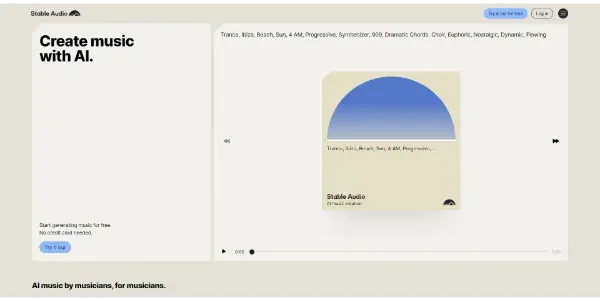Stable Audio 2

A music generator that transforms your text into a song (various musical genres are available). An AI created by Stability AI
Stable Audio 2: A Deep Dive into AI-Powered Music Generation
Stable Audio 2, developed by Stability AI, is a groundbreaking music generation tool that leverages the power of artificial intelligence to transform text prompts into fully realized musical compositions. Unlike simpler melody generators, Stable Audio 2 aims to create complete songs across various genres, offering a compelling alternative to traditional music composition methods.
What Stable Audio 2 Does
At its core, Stable Audio 2 acts as a sophisticated text-to-music engine. Users input a text description – be it a detailed lyrical concept, a mood suggestion, or a specific genre request – and the AI generates a corresponding musical piece. This process encompasses melody, harmony, rhythm, and instrumentation, resulting in a complete, listenable song. The tool goes beyond simple MIDI generation; it produces high-quality audio files ready for immediate use.
Main Features and Benefits
- Text-to-Music Generation: The primary feature is its ability to translate textual descriptions into music, opening up creative possibilities for users with limited musical expertise.
- Genre Versatility: Stable Audio 2 supports a wide range of musical genres, enabling users to explore diverse sonic landscapes. While the precise range isn't publicly specified, the promise is broad genre coverage.
- Customization Potential: While details on the level of customization are limited, the potential for manipulating various parameters (potentially tempo, instrumentation, key, etc.) is a key benefit to explore.
- High-Quality Audio Output: The generated audio is of a high enough quality for direct use in various applications, eliminating the need for post-processing in many cases.
- Accessibility: The free pricing model makes the tool accessible to a broad audience, including musicians, content creators, and hobbyists.
Use Cases and Applications
Stable Audio 2's applications span numerous creative fields:
- Music Production: Composers can use it to quickly prototype ideas, overcome creative blocks, or generate unique musical textures to integrate into their existing projects.
- Game Development: The tool can create original soundtracks and background music for video games, saving developers time and resources.
- Film and Video Production: It can generate bespoke musical scores for short films, documentaries, and other video projects.
- Content Creation: YouTubers, podcasters, and other content creators can use it to generate royalty-free music for their videos and audio projects.
- Educational Purposes: Stable Audio 2 can serve as an educational tool for aspiring musicians, demonstrating how different musical elements interact and contribute to overall composition.
Comparison to Similar Tools
While several other AI music generators exist (e.g., Amper Music, Jukebox), Stable Audio 2 distinguishes itself, at least conceptually, through its open-source nature and potentially broader range of customizable outputs (although further details are needed to definitively compare its capabilities). Other tools often focus on specific genres or offer more limited control over the generated music. A direct comparison requires more detailed information regarding the capabilities of Stable Audio 2's customization options.
Pricing Information
Currently, Stable Audio 2 is offered completely free of charge. However, it's important to note that this might change in the future as the tool evolves and its development continues.
Disclaimer: The information provided in this article is based on the description of Stable Audio 2. Further details regarding specific features and capabilities might become available as the tool matures and is further documented. It's recommended to consult the official Stable Audio 2 documentation for the most up-to-date information.